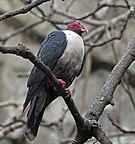The Papuan mountain pigeon (Gymnophaps albertisii) is a species of bird in the pigeon family Columbidae. It inhabits forests and lowlands on New Guinea, the Bacan Islands, the D'Entrecasteaux Islands, and the Bismarck Archipelago. It is a medium-sized pigeon, 33–36 cm (13–14 in) long and weighing 259 g (9.1 oz). Adult males have slate-grey upperparts, chestnut-maroon throats and bellies, whitish breasts, and a pale grey tail band. The lores and eye rings are bright red. Females are similar, but have greyish breasts and edges to the throat feathers. This pigeon feeds on figs and drupes. In the Schrader Range it breeds from October to March, but elsewhere may breed throughout the year. It builds a nest of sticks in a tree or in short dry grass, and lays a single egg. The species is very social and is usually seen in flocks of 10–40 birds, sometimes more. It is listed as a least-concern species on the IUCN Red List due to its large range and lack of significant population decline. (Full article...)
